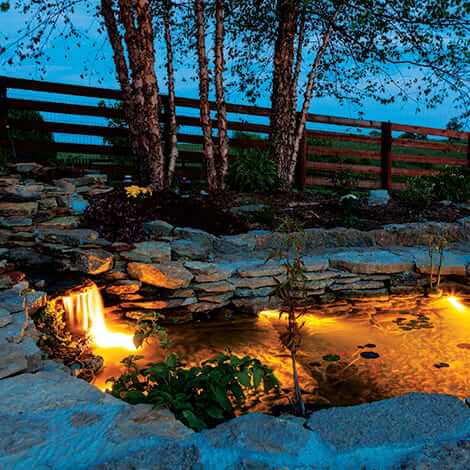Adding pond lights is a great way to bring your water garden or feature to life after dark. They add a focal point to your nighttime display and let you enjoy your pond after the sun sets. To ensure long-lasting performance and safety, consider the following tips for installing and maintaining pond lights.
Safety First
Water and electricity don’t mix, so select waterproof lights with seals and check your weatherproof power supply before installing. Your outlet should have a ground fault circuit interrupter (GFCI)—if it doesn’t, contact a professional to install one.
How to Install Pond Lights
Once you have selected a light set and checked your power supply, it is time to install your new lighting. Underwater lights are best installed when your pond is empty, such as during construction or while it’s drained for spring cleaning. If you cannot wait, consider an installation without submerged lights.
Position the pond lights facing the pond or place them under the waterfall, pointing away from the viewing area so visitors can enjoy the display without glares. Once each light is in place, wrap some excess cord around it to make retrieval easier, then obscure cords and hardware with plants and rocks.
Lighting Colors & Positioning
There are many fountain and water feature lighting options, from halogen to LED landscape lights designed for ponds. Here are just a few ideas to help you get started:
- Color Options: Most pond lights have a standard white light but often include color-filtered lenses. These lenses are an inexpensive way to highlight an area in your pond or landscape with a pop of color.
- Soft Glow: Create a soft glow by placing a waterproof light underneath any waterfall. Use white lighting or colored filters to capture the movement of flowing waterfalls at night.
- Single Bright Light: If you are looking for a single spotlight with high intensity, get the
LEDPro 12-Watt Light. It is an excellent low-energy option that uses only 12 watts but has the same glow as a 70-watt halogen bulb. Plus, these durable LED lights last longer than comparable halogen bulbs.
Pond Light Transformers
Most pond lights use 12-volt power and usually come with a transformer. However, if the lights you selected do not come with one, note the number of lights you will use and their wattages. Aquascape 12-Volt Transformers can accommodate low-voltage lighting systems up to 60 watts.
Tip: We recommend using only 90% of the transformer output to maximize light potential. For example, a 60-watt transformer should run a maximum of 54 watts, which equals nine 6-Watt LED Lights.
Photocells & Timers
If your new pond lighting includes a photocell, keep it out of the water in an area that receives direct sunlight with no obstructions. The photocell detects ambient light levels, turning the lights on at sunset and off at dawn. Light sets without a photocell or those you only want on until a particular time can be set on an automatic timer.
Maintenance
We recommend cleaning and inspecting light sets annually during your spring clean-out. If the intensity of your light is fading, give those lenses a good scrubbing, as they can accumulate debris or algae over time. Do not use chemicals or household cleaning agents on your lighting. If they are still dim after cleaning, you might need to replace them with fresh bulbs.
Pro Pond Lighting Tips
Do you still have questions about lighting up your pond at night? Contact us online or by phone at 866-POND-HELP for expert advice from our friendly pond professionals.
Read more about perfecting your pond aesthetic in the following related guides:
Easy Fish Pond Lighting
When to Install Pond Lighting
DIY Backyard Pond Kit Components
Add a Stream to Your Water Garden
Small Pond Waterfall Ideas & Inspiration
Last Updated: June 3, 2024
